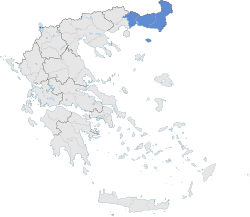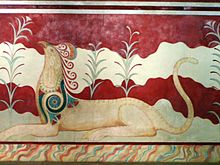The item on the pictures is the one that you will receive. Look carrefully and judge for your self for the quallity and the grade.
S&h is $6.90 for all the world.
Registered mail with international tracking number.
Original Proof coin from the National bank of Greece. Comes with Certificate Of Authenticity (C.O.A.) and Original Box.
BID WITH CONFIDENCE.
. SELLER with 100% POSITIVE FEEDBACK.
| Grouping | Mythological hybrids |
|---|---|
| Other name(s) | Griffon, gryphon |
The griffin, griffon, or gryphon (Ancient Greek: γρύψ, grū́ps; Classical Latin: grȳps or grȳpus;[1] Late and Medieval Latin:[2] gryphes, grypho etc.; Old French: griffon) is a legendary creature with the body, tail, and back legs of a lion; the head and wings of an eagle; and sometimes an eagle's talons as its front feet. Because the lion was traditionally considered the king of the beasts, and the eagle the king of the birds, by the Middle Ages, the griffin was thought to be an especially powerful and majestic creature. Since classical antiquity, griffins were known for guarding treasures and priceless possessions.[3]
In Greek and Roman texts, griffins and Arimaspians were associated with gold deposits of Central Asia. Indeed, as Pliny the Elder wrote, "griffins were said to lay eggs in burrows on the ground and these nests contained gold nuggets."[4]
In medieval heraldry, the griffin became a Christian symbol of divine power and a guardian of the divine.[5]
Etymology
The derivation of this word remains uncertain. It could be related to the Greek word γρυπός (grypos), meaning 'curved', or 'hooked'. It could also have been an Anatolian loan word: compare Akkadian karūbu (winged creature),[citation needed] and the phonetically similar cherub. A related Hebrew word is כרוב (kerúv).[6]
 Thrace (blue) within Greece | |
| Cession | 1920 |
| Replaced as administrative region by Eastern Macedonia and Thrace | 1987 |
| Capital | Komotini |
| Regional units | |
| Government | |
| • Deputy Minister | Theodoros Karaoglou (New Democracy) |
| Area | |
| • Total | 8,578 km2 (3,312 sq mi) |
| Population | |
| • Total | 371,208 (2011 census)[1] |
| • Density | 43/km2 (110/sq mi) |
| Demonym(s) | Thracian |
| Largest City | |
| Website | www |
Western Thrace or West Thrace (Greek: [Δυτική] Θράκη, [Dytikí] Thráki [ˈθraci] / Turkish: Batı Trakya; Bulgarian: Западна Тракия, Zapadna Trakiya or Беломорска Тракия, Belomorska Trakiya) is a geographic and historical region of Greece, between the Nestos and Evros rivers in the northeast of the country; East Thrace, which lies east of the river Evros, forms the European part of Turkey, and the area to the north, in Bulgaria, is known as Northern Thrace.
Inhabited since paleolithic times, it has been under the political, cultural and linguistic influence of the Greek world since the classical era;[2][3] Greeks from the Aegean islands extensively colonized the region (especially the coastal part) and built prosperous cities such as Abdera (home of Democritus, the 5th-century B.C. philosopher who developed an atomic particle theory, and of Protagoras, a leading sophist) and Sale (near present-day Alexandroupoli).[2] Under the Byzantine Empire, Western Thrace benefited from its position close to the imperial heartland and became a center of medieval Greek commerce and culture; later, under the Ottoman Empire, a number of Muslims settled there, marking the birth of the Muslim minority of Greece.
Topographically, Thrace alternates between mountain-enclosed basins of varying size and deeply cut river valleys. It is divided into the three regional units (former prefectures): Xanthi, Rhodope and Evros, which together with the Macedonian regional units of Drama, Kavala and Thasos form the Region of East Macedonia and Thrace.
The Fourth Army Corps of the Hellenic Army has its headquarters in Xanthi; in recent years, the region has attracted international media attention after becoming a key entering point for illegal immigrants trying to enter European Union territory; Greek security forces, working together with Frontex, are also extensively deployed in the Greco-Turkish land border.



